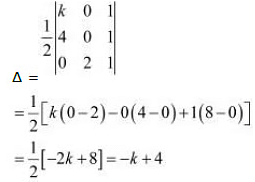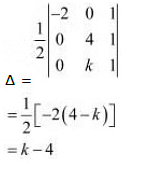NCERT Solutions Exercise 4.2: Determinants | Mathematics (Maths) Class 12 - JEE PDF Download
Q1: Find area of the triangle with vertices at the point given in each of the following:
(i) (1, 0), (6, 0), (4, 3)
(ii) (2, 7), (1, 1), (10, 8)
(iii) (−2, −3), (3, 2), (−1, −8)
Ans: (i) The area of the triangle with vertices (1, 0), (6, 0), (4, 3) is given by the relation,
(ii) The area of the triangle with vertices (2, 7), (1, 1), (10, 8) is given by the relation,
(iii)The area of the triangle with vertices (−2, −3), (3, 2), (−1, −8) is given by the relation,
Hence, the area of the triangle is |-15| = 15 sq units.
Q2: Show that points
A (a, b + c), B (b, c + a), C (c, a + b) are collinear
Ans: Area of ΔABC is given by the relation,
= 0
Thus, the area of the triangle formed by points A, B, and C is zero. Hence, the points A, B, and C are collinear.
Q3: Find values of k if area of triangle is 4 square units and vertices are
(i) (k, 0), (4, 0), (0, 2)
(ii) (−2, 0), (0, 4), (0, k)
Ans: We know that the area of a triangle whose vertices are (x1, y1), (x2, y2), and (x3, y3) is the absolute value of the determinant (Δ), where
(i) The area of the triangle with vertices (k, 0), (4, 0), (0, 2) is given by the relation,
∴ -k + 4 = ±4
When −k + 4 = − 4, k = 8.
When −k + 4 = 4, k = 0.
Hence, k = 0, 8.
(ii) The area of the triangle with vertices (−2, 0), (0, 4), (0, k) is given by the relation,
∴ k - 4 = ±4
When k − 4 = − 4, k = 0.
When k − 4 = 4, k = 8.
Hence, k = 0, 8.
Q4: (i) Find equation of line joining (1, 2) and (3, 6) using determinants
(ii) Find equation of line joining (3, 1) and (9, 3) using determinants
Ans: (i) Let P (x, y) be any point on the line joining points A (1, 2) and B (3, 6). Then, the points A, B, and P are collinear. Therefore, the area of triangle ABP will be zero.
Hence, the equation of the line joining the given points is y = 2x.
(ii) Let P (x, y) be any point on the line joining points A (3, 1) and B (9, 3). Then, the points A, B, and P are collinear. Therefore, the area of triangle ABP will be zero.
Hence, the equation of the line joining the given points is x − 3y = 0.
Q5: If area of triangle is 35 square units with vertices (2, −6), (5, 4), and (k, 4). Then k is
(a) 12
(b) −2
(c) −12, −2
(d) 12, −2
Ans:(d)
The area of the triangle with vertices (2, −6), (5, 4), and (k, 4) is given by the relation,
When 5 − k = −7, k = 5 + 7 = 12.
When 5 − k = 7, k = 5 − 7 = −2.
Hence, k = 12, −2.
The correct answer is (d).
|
203 videos|307 docs|139 tests
|





















